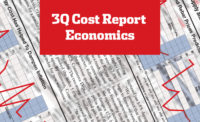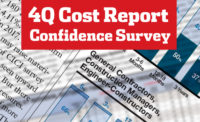As the world continues to battle the COVID-19 pandemic, the economic challenges that it has brought to the U.S. and across the globe linger as 2021 closes in.
“Economic growth is slowing, weighed down by rising COVID-19 infections and fading government support. The construction sector is feeling the impact,” says Richard Branch, chief economist at Dodge Data & Analytics.
Non-residential building starts dipped 25% on a year-to-date basis, according to Dodge, with notable drops in the commercial, institutional and manufacturing sectors. Non-building starts fell 16% in the same time period, which the firm largely attributes to the declines in the utility and gas plant market.
Branch points to growth in streets, bridges and sewers as a “glimmer of hope” in the non-building sector. In the last two months, the largest non-building projects to break ground were the $3.6 billion Hampton Roads Bridge and Tunnel Expansion in Norfolk, Va., and the $865 million I-275 Howard Franklin Bridge in Florida.
On the residential side, single-family housing continues to drive growth while multi-family starts have declined. Overall residential construction is
up 3% overall, year-to-date, according to Dodge.
As the year ends, there is “much doubt,” says Branch. “The uncertain outlook for additional federal stimulus and the lack of agreement on funding the federal government past Dec. 18 clouds the outlook,” he says, adding that “the next wave the of the virus is likely to lead to a slowdown in hiring, further hampering the recovery.”
Julian Anderson, president at Rider Levett Bucknall, expressed a similar viewpoint. “Congress has dithered over providing further relief to the hardest hit parts of the community, and the specter of the end of supplementary unemployment insurance and of the eviction moratorium, together with worsening state and municipal finances, does little to alleviate anxiety for the construction industry,” he says.
While both Branch and Anderson are hopeful that the newly approved COVID-19 vaccines will lead to economic recovery sometime in 2021, the latter analyst notes that “the U.S. must first get through a winter made more cruel by an increasing rate of COVID-19 infections and a rising death toll before things can return to ‘normal.’ ”
|
Related Link |
Lumber Price Hike Continues
After months of soaring prices, lumber prices leveled off in September and October, only to begin rising again in November, says Deni Koenhemsi, economics manager at IHS Markit. “Supply is not yet able to catch up with demand,” she says.
IHS Markit’s fourth-quarter forecast estimates a 25.6% increase in softwood lumber in 2020, up from 19.1% predicted in the third quarter forecast. Plywood lumber is forecast to rise 7.2%, while gypsum products are expected to stay flat though the end of this year.
IHS Markit also points to copper's price rise by more than 60% on the London Metal Exchange since the end of the first quarter of 2020, says John Mothersole, director of research.
He says the copper market is now “overbought and exposed to a correction,” adding that “profit-taking by investors, softness in consumption this winter outside of China because of the COVID second wave and a gradual end to mine disruptions set this market up for a modest retrenchment in the first half of 2021.”




.jpg?height=200&t=1671747499&width=200)

Post a comment to this article
Report Abusive Comment